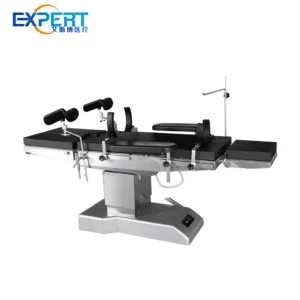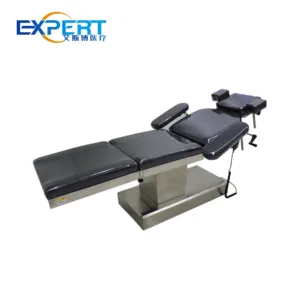Address
304 North Cardinal St.
Dorchester Center, MA 02124
Work Hours
Monday to Friday: 7AM - 7PM
Weekend: 10AM - 5PM
Welcome to My Blog!
Before we dive into the content, if you’re interested in our products or have any questions, please feel free to visit our Contact Us page on the website. Our team is ready to assist you with inquiries, orders, or any support you may need.
Now, let’s get started on our journey together. I hope you find the content here insightful, engaging, and valuable.

Operating tables are essential equipment in surgical settings, providing a stable platform for patients during medical procedures. With advancements in technology and healthcare practices, a wide range of operating tables have been developed to cater to different surgical needs. In this comprehensive guide, we will delve into the various types of operating tables available, highlighting their features, benefits, and applications in the medical field.


Operating tables play a crucial role in ensuring the safety and comfort of patients undergoing surgical procedures. A well-designed operating table provides surgeons with optimal access to the surgical site, facilitates patient positioning, and supports the efficient execution of medical interventions. By choosing the right type of operating table, healthcare providers can enhance the quality of care delivered to patients and improve surgical outcomes.
General Surgical Tables: These versatile tables are designed for a wide range of surgical procedures, including general surgery, orthopedic surgery, and neurosurgery. General surgical tables typically feature adjustable height, tilt, and positioning capabilities to accommodate various surgical specialties.
Specialty Surgical Tables: Specialty tables are tailored to specific surgical disciplines, such as cardiovascular surgery, urology, and ophthalmology. These tables may have specialized attachments, such as leg holders, arm boards, or headrests, to support the unique requirements of different procedures.
Imaging Tables: Imaging tables are equipped with radiolucent surfaces that allow for intraoperative imaging, such as X-rays, fluoroscopy, or MRI. These tables enable surgeons to perform minimally invasive procedures with real-time imaging guidance, enhancing precision and accuracy during surgery.
Bariatric Tables: Bariatric tables are designed to accommodate patients with obesity or higher weight capacities. These tables feature reinforced construction, wider surfaces, and enhanced weight-bearing capabilities to ensure the safety and comfort of bariatric patients during surgery.
Electro-hydraulic Tables: Electro-hydraulic tables utilize hydraulic systems to adjust table positions, including height, tilt, and lateral tilt. These tables offer smooth and precise movements, allowing surgeons to make quick adjustments during procedures without disrupting the surgical field.
-1.jpg)
| Type | Features | Applications |
|---|---|---|
| General Surgical | Versatile, adjustable height and tilt | General surgery, orthopedics, neurosurgery |
| Specialty Surgical | Tailored to specific disciplines | Cardiovascular, urology, ophthalmology |
| Imaging | Radiolucent surfaces for imaging | Minimally invasive procedures |
| Bariatric | Reinforced construction, higher weight capacities | Bariatric surgery |
| Electro-hydraulic | Hydraulic adjustments for precise positioning | Quick adjustments during surgery |
In conclusion, the selection of the appropriate operating table is paramount in ensuring the success of surgical procedures and the well-being of patients. By understanding the various types of operating tables available and their respective features and applications, healthcare providers can make informed decisions that optimize surgical outcomes and patient care.Healthcare facilities should prioritize investing in high-quality operating tables that meet the specific needs of their surgical specialties. Regular maintenance and proper training for staff on how to use the operating table effectively are also crucial factors in ensuring its longevity and optimal performance. By placing importance on these aspects, healthcare providers can create a safe and efficient surgical environment that promotes positive patient outcomes and overall satisfaction.
What are the different types of operating tables available in the market?
Operating tables come in various types, including hydraulic, electric, specialty (such as orthopedic or radiolucent), and bariatric tables. Each type offers unique features and functionalities to cater to different surgical needs.
How do I choose the right type of operating table for my surgical facility?
When selecting an operating table, consider factors such as the types of surgeries performed, patient demographics, budget constraints, and compatibility with existing equipment. Consulting with surgeons and healthcare professionals can also provide valuable insights into the specific requirements of your facility.
What are the advantages of hydraulic operating tables compared to electric ones?
Hydraulic operating tables are known for their durability, reliability, and smooth adjustments. They are often preferred for their cost-effectiveness and ease of maintenance. In contrast, electric operating tables offer precise control, motorized adjustments, and advanced features like memory presets and compatibility with imaging equipment.
Are there operating tables designed for specialized surgical procedures?
Yes, specialty operating tables are tailored to meet the unique requirements of specific surgical specialties. For example, orthopedic tables feature specialized attachments for joint surgeries, while radiolucent tables allow unobstructed imaging during procedures like spinal surgery. Bariatric tables are designed to support heavier patients safely.
How important is patient positioning on the operating table for surgical outcomes?
Patient positioning plays a crucial role in surgical outcomes, as it affects access, visibility, and the effectiveness of the procedure. Operating tables with adjustable height, tilt, and lateral tilt capabilities enable surgeons to achieve optimal patient positioning, leading to better surgical outcomes and reduced risk of complications.
